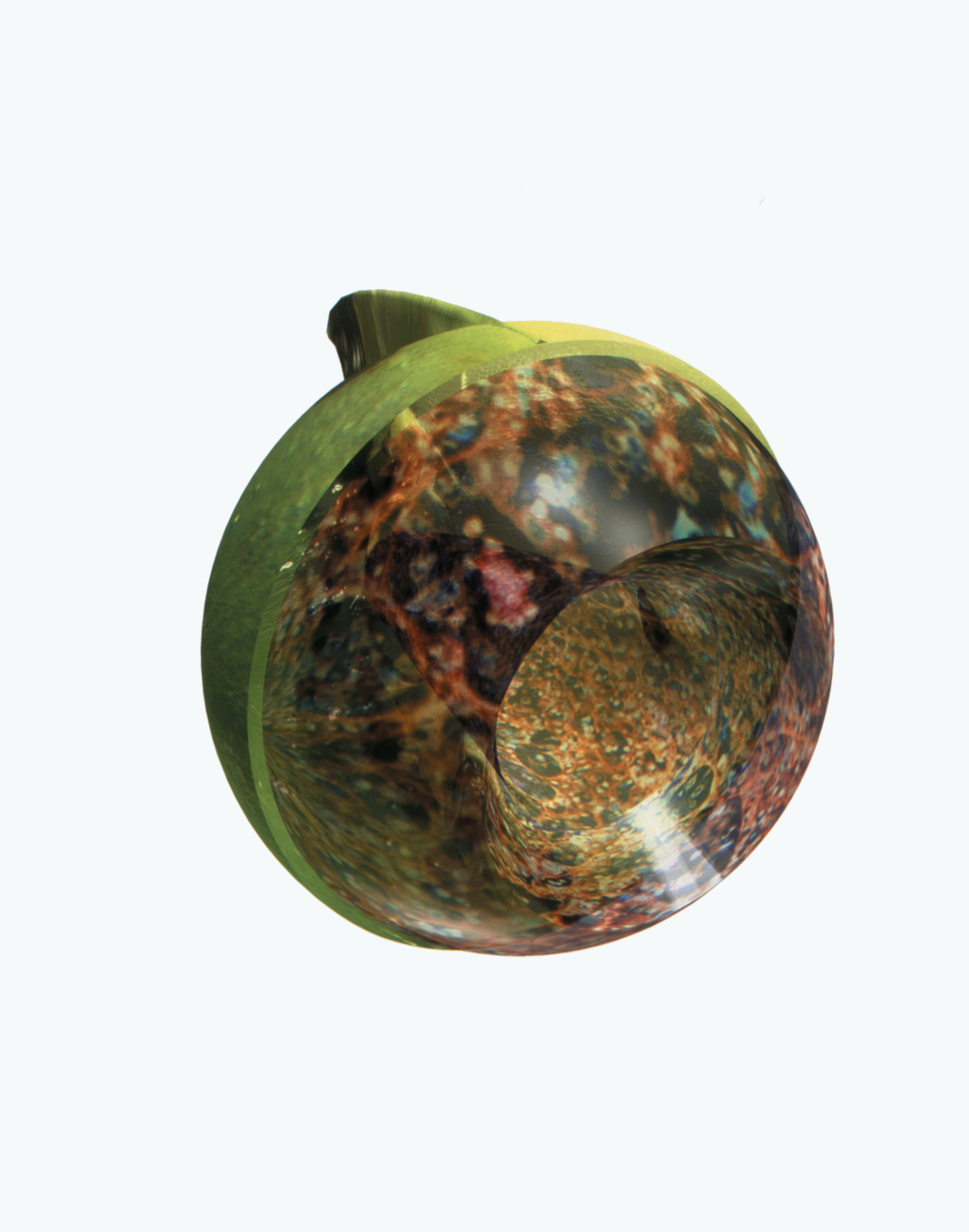Cyborgs - Haraway and Duchamp revisited
The bachelors, stripped bare by their bride, even
intro & Making of cyborgs Haraway 6 Duchamp
stills: about cyborges flying about
(animations: about Cyborgs flying about & Duchamp explode,wip)
The bachelors, stripped bare by their bride, even
The cyborgs “Ahne 1, Ahne 2, Ahne 3” and further cyborgian makings refer to Marcel Duchamp’s Large Glass: The bride, stripped bare by her bachelors, even. The bachelors from the lower part of the glasswere stripped off their uniforms, revealing the pink gas which Duchamp mentioned they would be filled with. I called my 3-d simulation accordingly: The bachelors, stripped bare by their bride, even. Although bachelors, at least in Duchamp’s time, usually have no descendants, Duchamp calls them “bachelors like ancestors” in his notes. Parts of the simulated male molds are used to construct the cybernetic component for the cyborg series Ahne 1, Ahne 2, Ahne 3, while the female material component consists of organic cellular material: microbiological images of human liver-cells fuse with macroscopic images of a kiwi.

The bachelors, stripped bare by their bride, even Color dye sublimation print
Ahne 1, Ahne 2, Ahne 3
Ahne 1, Ahne 2, Ahne 3 images seem to be an object, taken from different perspectives – but the material components also change their locations, and thus further questioning the identity of the cyborg. Neither a taxonomy of Ahne 1, Ahne 2, Ahne 3, nor the number of identities can be clearly identified. The title “Ahne” can be understood as an imperative of the verb to anticipate (ahnen) and can refer to the future: an foreboding is directed forward, into unknown periods of time. The word “Ahne” can also be read as a noun, in the sense of an ancestor. This reverses the line of vision from the present to the past: an ancestor does not come into existence until he/she has produced descendants who retroactively define him/her as an ancestor. The cyborg asserts its existence despite its extremely heterotopic as well as heterochronous ambivalence from the most diverse perspectives.
The making of Cyborgs – Donna Haraway revisited
The Making of Cyborgs refer to Donna Haraway, A Manifesto for Cyborgs: Science, Technology, and Socialist Feminism in the 1980s, subtitle An Ironic Dream of a Common Language for Women in the Integrated Circuit, 1985. The German versions title was »Lieber Kyborg als Göttin! Für eine sozialistisch-feministische Unterwanderung der Gentechnologie«, in: Gulliver, Deutsch-englische Jahrbücher, hgg. v. B.-P.Lange u. A.M.Stuby, Berlin 1984
To recapitulate, certain dualisms have been persistent in Western traditions; they have all been systemic to the logics and practices of domination of women, people of color, nature, workers, animals – in short, domination of all constituted as others, whose task is to mirror the self. Chief among these troubling dualisms are self/other, mind/body, culture/nature, male/female, civilized/primitive, reality/appearance, whole/part, agent/resource, maker/made, active/passive, right/wrong, truth/illusion, total/partial, God/man. The self is the One who is not dominated, who knows that by the service of the other: the other is the one who holds the future, who knows that by the experience of domination, which gives the lie to the autonomy of the self. To be One is to be autonomous, to be powerful, to be God; but to be One is to be an illusion, and so to be involved in a dialectic of apocalypse with the other. Yet to be other is to be multiple, without clear boundary, frayed, insubstantial. One is too few, but two are too many. (D. Haraway, 1984: 96)
The making of Cyborgs – Marcel Duchamp revisited
Not to forget the imaginary sex polygon
(Das imaginäre Sex-Polygon nicht vergessen, Marcel Duchamp (1914) from die Schriften 1981, Regenbogen Verlag, Zürich, , No. 48, p. 111) I revisited the Large Glass by Marcel Duchamp: The bride stripped naked by her bachelors, even. It was created a few years after the advent of the theory of relativity. Described by Serge Stauffer as a peep-show for intellectuals, it consists of an erotically charged fictional mechanic that takes place between the two halves of the picture, the female upper and the male lower. Here, a gas escapes from the otherwise hollow 9 bachelors and is attracted to the amorphous and lifeless, since hanged, bride. The sexist background on which Duchamp designs his constructions is often left out of the reception.
Regarding the bachelors, Duchamp wrote:
It was simply a matter of making a direct opposition to the theme of the bride, which I believe was given to me by those fairground booths that swarmed at the time, where mannequins, often representing the characters of a wedding, offered themselves to be decapitated thanks to the skill of the ball-throwers.
Duchamp refers in his writings to the fourth dimension and to mathematical theories of his time.
I found that the shadow of a three-dimensional object constitutes a two-dimensional form … and concluded, by analogy, that the fourth dimension could project an object with three dimensions, i.e. that all three-dimensional objects that we look at so guilelessly are projections of four-dimensional forms unknown to us. In this spirit, I created the newlywed (la mariée, the bride, d.V.) in the Large Glass as a projection of an invisible four-dimensional form.
(Marcel Duchamp die Schriften 1981, Regenbogen Verlag, Zürich, , No. 48, p. 307)

Ahne 1 cibachrome on alu-dibond

Ahne 2 cibachrome on alu-dibond

Ahne 3 cibachrome on alu-dibond
more cyborgs




